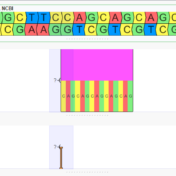When interpreting fusions in their VCF format, it is not easy immediately grasp which side of the positions are adjacent in the resulting fusion. When interpreting and troubleshooting fusion variants, I usually find myself reaching for the VCF spec. If you, like me, are looking to speed up this process and gain a quick understanding of the fusions in your… Read more »
Large genetic cohorts require substantial effort to analyze. Genetic researchers are increasingly turning to whole exome and whole genome sequencing analyses for their clinical diagnostics and research. However, with that approach comes the challenge of making sense of these massive datasets. This is especially challenging when looking for tools that can streamline variant analysis for large genetic cohorts and include… Read more »
Manually converting FASTQs to VCFs, importing these into VarSeq, and building projects from scratch is adequate when you have only a handful of cases per week. But as you start ramping up production, the key to your lab’s success quickly becomes how quickly and efficiently you can get to the reporting of your analysis. This blog will explain how you… Read more »
VCF file format comes with a lot of interesting quality assurance and statistics fields that can be used for filtering in VarSeq. Open your files in a text editor to see all the fields that are available in your files, each field will have a header line with a description of its content. See the VCF Specifications to help with… Read more »
Merging variant records, VCFs, across samples is important when performing trio or family analysis as it ensures that hereditary relationships can be properly inferred. There are many ways to represent a single variant. Insertions and deletions may be right or left aligned, prefixes and suffixes can be added, and adjacent variants in the same sample may be combined or split… Read more »
The Beginning of Your Tertiary Analysis VarSeq is designed to be your NGS tertiary analysis solution providing users simple but in-depth means of exploring gene panel, exome, and whole genome variants. For those not accustomed to the VarSeq software, the main import file for variant analysis is the VCF. Those who are familiar with the VCF know that there can… Read more »
SVS offers options for performing many different QC functions on genomic data. This blog takes you through some of the most commonly applied filters for various analysis types. Filters for GWAS data vary depending on the type of association tests you are performing. A typical GWAS for a common variant usually requires filters to remove problematic or poorly called variants,… Read more »
I’m sitting in the Smithsonian Air and Space Museum basking in the incredible product of human innovation and the hard work of countless engineers. My volunteer tour guide started us off at the Wright brother’s fliers and made a point of saying it was only 65 years from lift off at Kitty Hawk to the landing of a man on the moon…. Read more »
“Who has ever had a bad experience with a VCF file?” I like to ask that question to the audience when I present data analysis workshops for Golden Helix. The question invariably draws laughter as many people raise their hands in the affirmative. It seems that just about everybody who has ever worked VCF files has encountered some sort of… Read more »




